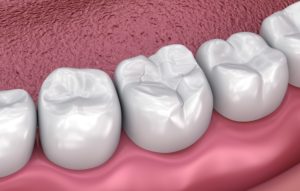 Although cavities are preventable, 92% of adults have had at least one. Fillings are the most common method of treating decay. They are designed to serve as a long-term solution, but they’ll need to be replaced, eventually. How long do fillings last? There’s no cut-and-dry answer because many factors affect their lifespan, like the materials used. While every situation differs, here’s how long you can expect your filling to last before needing a new one.
Although cavities are preventable, 92% of adults have had at least one. Fillings are the most common method of treating decay. They are designed to serve as a long-term solution, but they’ll need to be replaced, eventually. How long do fillings last? There’s no cut-and-dry answer because many factors affect their lifespan, like the materials used. While every situation differs, here’s how long you can expect your filling to last before needing a new one.
The Lifespan of Dental Fillings
Many materials are used to make fillings, like metals, composite, and ceramics. The material used will affect the life expectancy of your restoration. The average lifespan of the most common filling materials includes:
- Amalgam: 15 years
- Composite: 7 years
- Ceramic: 15 years
- Glass Ionomer: 5 years
Besides the materials, the duration of your results is also affected by:
- Oral Hygiene: Good oral hygiene will keep new decay at bay and preserve your filling. Commit to brushing your teeth at least twice daily for 2 minutes each session. Use a soft-bristled toothbrush and fluoride toothpaste to protect your smile from cavities. Don’t forget to floss your teeth every night before heading to bed.
- Diet: Limiting sugary foods and drinks will prevent tooth decay. Your dentist will recommend having hard and sticky foods in moderation. It’s best to skip drinking any alcohol, which can weaken the filling’s bond with your tooth over time.
- Lifestyle Habits: It’s best to break any bad oral habits, like chewing on your fingernails, using your teeth in place of scissors and other tools, or smoking.
- Regular Dental Care: Visiting your dentist every 6 months for a cleaning and checkup will ensure you get the most out of your filling.
Signs You Need a New Filling
With the right care at home and routine dental appointments, your filling can thrive for years; however, it won’t last forever. It’s important to schedule an appointment with your dentist at the first sign of a failing restoration, which may include:
- Sensitivity to hot or cold foods and drinks.
- Visible damage to the filling, like chipping or cracking.
- Change in the color of your tooth.
- Pain when placing pressure on the tooth.
In some cases, the filling can fall out completely, which will require a trip to your emergency dentist. You can avoid an unplanned visit to your dentist by maintaining your semi-annual cleanings and checkup. Your dentist will check your restoration at each visit to ensure it’s undamaged and functioning as intended. They’ll know when it’s time to replace it before it becomes a big problem. You’ll ensure your tooth has the protection it needs to last for a lifetime.
About Dr. James K. Kramer
Dr. Kramer earned his dental degree from the Temple University School of Dentistry and continued his education in advanced studies, like periodontics, endodontics, and oral surgery. He is a proud member of many professional organizations, including the Academy of General Dentistry and the American Dental Association. If you need a new filling, contact our office today to request an appointment.
